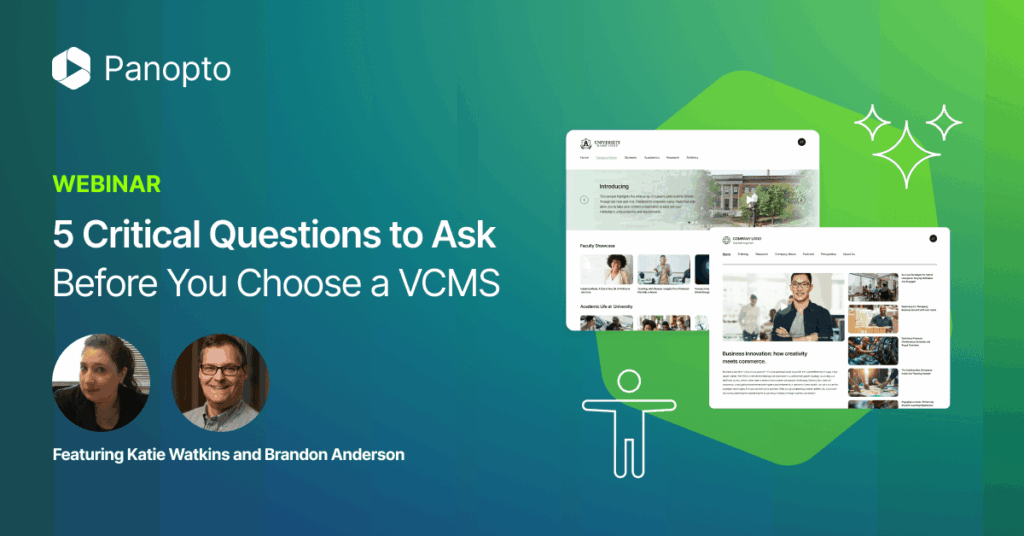This article was originally written and published by Panopto in partnership with Elai.
What if the video platform you choose today easily scales to meet future needs, maximizes your budget, preserves critical knowledge, and supports widespread adoption across your institution?
Video has become the backbone of higher education and corporate learning. From lectures and seminars to corporate training and compliance programs, video enables organizations to capture expertise, disseminate insights, and scale learning efficiently. However, choosing the right video content management system (VCMS) isn’t just about features; it’s a strategic investment that impacts operational efficiency, stakeholder engagement, and long-term ROI.
In a recent Panopto webinar, “5 Critical Questions to Ask Before You Choose a VCMS,” experts explored practical guidance for institutions and organizations navigating budget constraints, evolving priorities, and the increasing demand for scalable video solutions. The discussion provided a framework for evaluating video platforms beyond marketing promises, focusing on real-world outcomes and measurable impact.
Here are the five critical questions every decision-maker should ask.
Question 1: How Can the Platform Scale Without Breaking Your Budget?
Scalability is one of the most common challenges institutions face. As video usage expands across courses, departments, or teams, costs can rise faster than the benefits. A platform that cannot scale efficiently creates friction: staff spend more time troubleshooting issues, IT budgets balloon, and decision-makers question the investment.
The key is to assess licensing fees and the full financial picture. Storage, streaming, and support costs can add up quickly if not carefully evaluated. The right VCMS provides predictable costs while enabling user and content growth. It should also offer flexibility in deployment and storage options, ensuring that scaling up doesn’t mean scaling expenses proportionally.
By prioritizing platforms with transparent cost structures and scalable architecture, organizations can confidently expand their video programs without fear of budget overruns.
Question 2: Will It Preserve Institutional Knowledge?
Institutional knowledge is one of the most valuable assets a university or company can have. Every recorded lecture, training session, or expert demonstration represents expertise that can be lost if not properly captured and managed.
A robust VCMS functions as a central repository, transforming recorded content into searchable, actionable knowledge. Features such as AI-powered search, metadata tagging, and transcript indexing allow employees and learners to find critical information quickly. Without these capabilities, valuable content can remain buried, inaccessible, or forgotten.
Brandon Arentson, Sr. Director of Intelligent Automation and Data Analytics at Cox Enterprises, highlighted how structured video libraries allow corporate teams to efficiently deploy training and knowledge resources across geographies and departments. Similarly, centralizing faculty content in higher education ensures lectures and learning resources remain accessible for future cohorts, preventing knowledge loss as instructors move on or retire.
Question 3: Can Training Be Scaled Efficiently Without Adding Staff?
Expanding training initiatives doesn’t need to mean hiring more personnel. Efficiency is critical, especially for organizations with constrained budgets or small teams. The right VCMS streamlines workflows, automates repetitive tasks, and empowers end users to create and manage content independently.
Automated captioning, intuitive editing tools, and AI-assisted content management reduce the operational burden on staff while improving accessibility and engagement. For institutions or corporations handling hundreds or thousands of videos, these features can distinguish between a sustainable program and one that consumes disproportionate resources.
Katie Watkins, IT Technical Director at The Wharton School, emphasized that high-performing platforms should make technology “disappear” in the service of content and learning. Learning programs are more effective when users can focus on teaching or training rather than technical hurdles, and teams operate at maximum efficiency.
Question 4: How Future-Ready Is the Platform?
Technology evolves quickly, and a VCMS must adapt. Future-readiness is not about flashy features but flexibility, integration, and adaptability. Platforms designed to evolve alongside AI tools, learning management systems, and accessibility standards protect long-term investments and minimize the risk of obsolescence.
A future-ready VCMS supports new teaching, training, and content delivery methods. AI-powered tools such as automated content recommendations, search enhancements, and intelligent indexing not only increase productivity but also ensure organizations remain competitive. Choosing a platform that can integrate with emerging technologies and scale to meet evolving needs avoids the costly cycle of replacing outdated systems.
Question 5: Will It Build Consensus Across Stakeholders?
Even the most powerful technology fails without adoption. For a VCMS to succeed, it must effectively serve multiple groups. Faculty, administrators, IT teams, training managers, and leadership must all see tangible value. Multi-use capabilities like supporting teaching, training, communications, and compliance create alignment and reduce resistance.
Building consensus requires intuitive, adaptable platforms that benefit each stakeholder group. When users recognize immediate value and long-term benefits, adoption grows organically. As Katie Watkins noted, the right platform enables seamless experiences that connect people with content, fostering engagement across departments and ensuring programs thrive.
Considering Total Cost of Ownership
A strategic VCMS evaluation looks beyond features or licensing fees. Total ownership costs include setup, integrations, support, training, storage, and potential hidden expenses. By assessing these factors upfront, organizations can make informed decisions and build a stronger ROI case for leadership. Understanding the full financial and operational impact ensures that investments deliver both immediate and lasting value.
Making a Confident Choice
Choosing a VCMS is more than a technical decision. It’s a strategic move that affects knowledge preservation, operational efficiency, and stakeholder engagement. By focusing on scalability, institutional knowledge, training efficiency, future readiness, and multi-stakeholder alignment, organizations can select a platform that delivers measurable ROI and long-term success.
Brandon Arentson emphasized that capturing and organizing video content effectively transforms it into actionable insights, allowing knowledge to be quickly deployed and leveraged across an organization. These principles, applied thoughtfully, enable any institution to make video a central pillar of learning and organizational growth.
Ready to explore these insights in depth and learn how to choose a VCMS that supports your strategic goals, scales efficiently, and preserves institutional knowledge?
